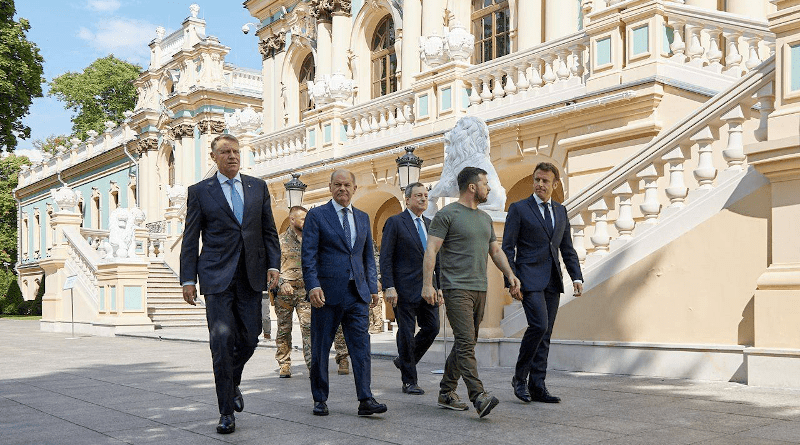French, German and Italian Leaders Visit Kyiv
By VOA
French President Emmanuel Macron, German Chancellor Olaf Scholz and Italian Prime Minister Mario Draghi visited Kyiv on Thursday in a show of support to Ukraine amid its battle to fend off Russia’s invasion.
“It’s an important moment. It’s a message of unity we’re sending to the Ukrainians,” Macron said.
The trip comes as the European Commission considers whether to recommend Ukraine be granted candidate status for European Union membership.
While in Kyiv, Macron, Scholz and Draghi met with Ukrainian President Volodymyr Zelenskyy.
Military aid
The United States announced Wednesday it is sending $1 billion more in military aid to Ukraine, Washington’s 12th and biggest tranche yet of weaponry and equipment intended to confront Russia’s slow but relentless advance on Ukraine’s eastern Donbas region.
National Security Council spokesman John Kirby told reporters at the White House the aid includes $350 million of equipment coming directly from the U.S. military, including 18 high-powered mobile long-range howitzers, 36,000 rounds of ammunition and 18 tactical vehicles to tow the howitzers, along with additional ammunition and other equipment.
Kirby said the remaining $650 million in aid, including coastal defense systems, radios, night vision devices and other equipment, will be purchased by the Pentagon from weapons manufacturers through a funding mechanism known as the Ukraine Security Assistance Initiative.
Kirby said the United States has provided more than $914 million in humanitarian assistance to Ukraine since the beginning of the invasion on February 24, including an additional $225 million announced Wednesday by President Joe Biden. Biden said in a statement the new money will fund safe drinking water, critical medical supplies and health care, food, shelter, and cash for families to purchase essential items.
“The bravery, resilience, and determination of the Ukrainian people continues to inspire the world,” Biden said. “And the United States, together with our allies and partners, will not waver in our commitment to the Ukrainian people as they fight for their freedom.”
The aid announcement came as U.S. Defense Secretary Lloyd Austin met in Brussels with allied defense ministers from more than 45 countries that have been supplying armaments to Ukraine’s forces. Russia is attempting to take full control of eastern Ukraine after failing earlier in the 3½-month invasion to topple Zelenskyy’s government or capture the capital, Kyiv.
Opening the talks with the Ukraine Defense Contact Group, Austin said Western allies remain “committed to do even more” to help Ukraine defend itself against Russia’s invasion at what he characterized as a “critical moment on the battlefield.”
On Thursday, at a NATO ministerial meeting, Austin called Russia’s invasion an “enormous crisis in European security,” but said, “Together we have risen to the challenge of Putin’s war of choice and Russia’s assault on trans-Atlantic security.”
Even before Biden’s announcement of new military assistance, the United States and its allies supporting Ukraine had sent billions of dollars of weaponry and ammunition to assist Ukraine’s fighters.
But U.S. General Mark Milley, chairman of the Joint Chiefs of Staff, provided a grim assessment of the current battlefield situation on the sidelines of the Brussels conference, telling reporters that the Ukrainian military is suffering as many as 300 casualties a day, including 100 soldiers killed in action and between 100 to 300 wounded.
“For Ukraine, this is an existential threat,” Milley said. “They’re fighting for the very life of their country. So, your ability to endure suffering, your ability to endure casualties is directly proportional to the object to be obtained.”
Ukraine has continued to push for more military aid and to get it to the front lines more quickly, as its forces face daunting odds in the Donbas region.
Representative Adam Smith, chairman of the U.S. House Armed Services Committee, told members of the Defense Writers Group, “We need to be giving more sophisticated systems, particularly when it comes to drones and long-range artillery. I don’t think we have been fast enough to get the Ukrainians the drones we have available.”
He added, “The way the fight is playing out right now, certainly, the Russians have more artillery. The Russians right now have better ISR (intelligence, surveillance and reconnaissance). They have better drones going out and seeing Ukrainian artillery positions. The Ukrainians don’t have that same visibility.”
Despite Russian claims of targeting and hitting Western weapon deliveries, Smith said, “We are still capable of getting a lot of weapons into Ukraine, and we’re seeing them being used in the battlefield.”
Other U.S. officials also played down the Russian assertions.
“We have not seen a lot of evidence of the Russian claims,” a senior U.S. defense official told reporters late Wednesday, speaking on condition of anonymity in order to discuss sensitive details.
But while the official dismissed concerns about recent Russian gains, he expressed confidence that the badly needed assistance would reach Ukraine in time to make “a significant difference.”
“We’re likely to be in this phase for a while,” the official said. The Russian gains continue to be incremental.”
National security correspondent Jeff Seldin and White House correspondent Anita Powell contributed to this report.

